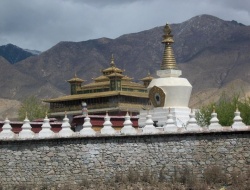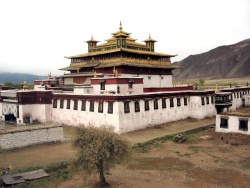Bsam yas debate
Among Western scholars, the Bsam yas Debate has generated more speculation than any other single event in Tibetan history. Around 797 C.E., a philosophical debate is said to have taken place at BSAM YAS (SAMYE), the first Buddhist monastery in Tibet. The debate was held in order to decide, in effect, which form of Buddhism would be adopted by the Tibetan royal court— that of the Chinese CHAN SCHOOL or Indian Buddhism. The debate was presided over by the Tibetan king, Khri srong lde btsan (r. 755–797), and the two sides were represented by the Chinese master Huashang Moheyan (Sanskrit, Mahayana) and the Indian scholar Kamalashila, respectively. According to Tibetan sources, the Indian side was declared the winner; Moheyan and his disciples were banished from the country, and Indian Buddhism was established as the state religion. The alleged victory for the Indian side has strongly shaped Tibetans’ understanding of their own religious heritage.
The philosophical issue at stake was how enlightenment should be attained—immediately or after a period of extensive training. Thus, according to the famous history (Chos ’byung) composed by BUSTON (BUTÖN) rin chen grub (1290–1364), Moheyan opened the debate by explaining that just as clouds, be they white or black, obscure the sky, so do all activities, be they virtuous or nonvirtuous, perpetuate REBIRTH in SAMSARA. Therefore, he concluded, the cessation of all mental activity leads immediately to the highest liberation. Kamalashila responded to this philosophical quietism by explaining the stages of analytic meditation.
He stressed that even nonconceptual wisdom results from a specific process of gradual analysis. Moheyan was soundly defeated, and some of his disciples were so humiliated that they committed suicide. Buston’s account, which is largely representative of the normative Tibetan historical tradition, is clearly a biased one. He frames his narrative with a prophecy made by Santaraksita, the Indian master who helped to establish Bsam yas and ordained the first nine Buddhist monks in Tibet. Here, shortly before his death, Santaraksita predicts a controversy between two Buddhist groups and instructs that his disciple, Kamalashila of Nalanda, should be summoned to resolve the dispute. Bu ston’s account then closes with a story vilifying Moheyan, in which the Chinese master sends some “Chinese butchers” to murder Kamalashila by squeezing his kidneys.
This Tibetan version of events has been complicated by the discovery of a Chinese work titled the Dunwu dasheng zhengli jue (Verification of the Greater Vehicle of Sudden Awakening). The text was unearthed from the caves at DUNHUANG, a region once frequented by Moheyan. A translation was first published by Paul Demiéville in his 1952 article, Le concile de Lhasa. The Chinese work purports to be a word-for-word record of the debate written by Wangxi, a direct disciple of Moheyan. Its version of events differs radically from those of the various Tibetan sources; in this version, Moheyan wins the debate. This discovery has led some scholars to doubt the very existence of the debate, suggesting that instead it should be viewed as indicative of an ongoing controversy through a series of only indirect encounters between Chinese and Indian factions at the Tibetan royal court. That said, it remains that all available sources agree that a debate of some kind did take place.
It is unclear whether Kamalashila knew about the Chinese text when, apparently at the Tibetan king’s request, he composed his three famous treatises summarizing the debate’s central themes, each called a Bha� vana� krama (Stages of Meditation). The Indian and Chinese works address many of the same topics, but part ways on a number of important points. The Chinese work, for example, gives considerable attention to the doctrine of TATHAGATAGARBHA (buddhanature), while Kamalashila does not even mention it. Similarly, the Chinese work remains silent on a number of issues that are crucial to Kamalashila’s argument—the need to develop compassion and the stages of meditation are two examples. Both texts, it seems, reflect their authors’ concerns with developments in their own countries more than with each other.
It is unclear whether all three of Kamalashila’s works were composed in Tibet.
Indeed, the teachings of Moheyan should be understood within the context of eighth-century Chinese Chan, itself a milieu of highly charged polemics. According to other Dunhuang documents, Moheyan belonged to the lineage of the Northern school of Chan. This school had already come under attack earlier in the eighth century by Shenhui (684–758) of the so called Southern school, and its lineage continued to be contested from many sides throughout Moheyan’s lifetime. Such a polarizing environment certainly would have influenced Moheyan, and the fragments of his teachings found at Dunhuang support the common view of him as extreme in his advocacy of immediate enlightenment.
In addition to its doctrinal ramifications, the Bsam yas Debate certainly had a strong political component. The nature of these more political concerns can be detected in yet another work that discusses the debate. The Sba bzhed (Testimony of Ba) is an early Tibetan account of the relevant period, purportedly written by a minister to Khri srong lde btsan. Several editions of the work exist, and all agree that the Indian side won. A close reading of the various Sba bzhed editions suggests that a central issue driving the debate may have been the Tibetan court’s adoption of the Indian Buddhist cosmological framework. This framework, with its “lawlike operation of karma,” may have offered eighth-century Tibetans an attractive foundation for political governance. According to this reading, it was the antinomian aspect of the popular Chinese teachings that threatened the new political order.
All such interpretations of the Bsam yas Debate remain, however, just that—interpretations. All we can
say for certain is that the debate has served a number of different ends. In the later Tibetan tradition, the debate was used as evidence for India’s importance as the only authentic source for Buddhist teachings. The debate also served as a weapon in polemical disputes between opposing Tibetan Buddhist groups. Perhaps the most well-known example of this trend appears in the writings of SASKYA PANDITA (SAKYA PANDITA, 1182–1251). There, the author equates the Moheyan side with the Tibetan tradition of Rdzogs chen by criticizing the “Self-Sufficient White Remedy” (dkar po chig thub) doctrine of the BKA’ BRGYUD (KAGYU) pa for being like the “Rdzogs chen of the Chinese tradition” (rgya nag lugs kyi rdzogs chen). Possible links between Chinese Chan and early Tibetan Rdzogs chen remain unclear, but the two teachings appear to bear some similarities, and these were certainly what caught the attention of later Tibetan polemicists.

